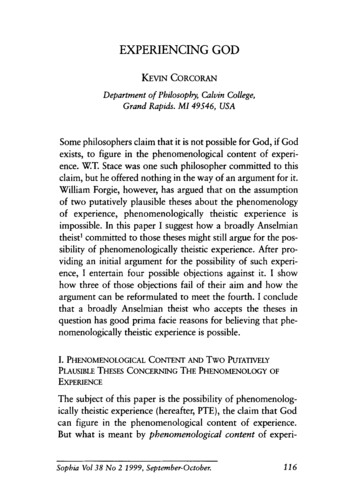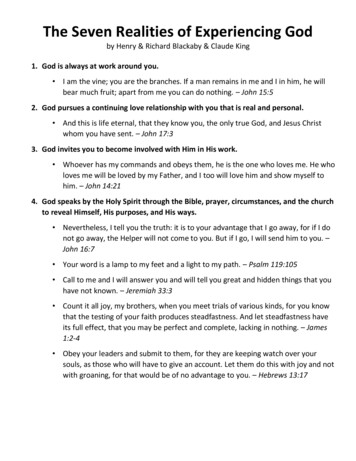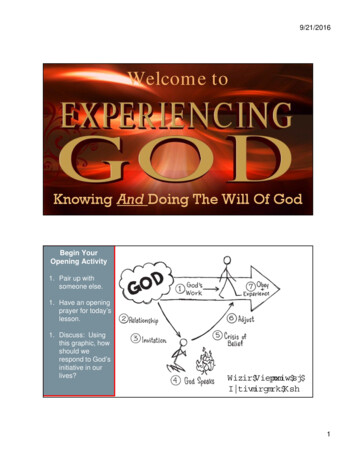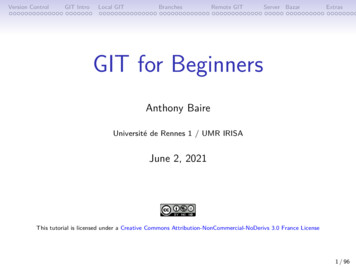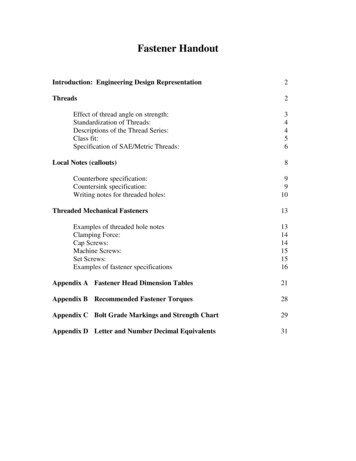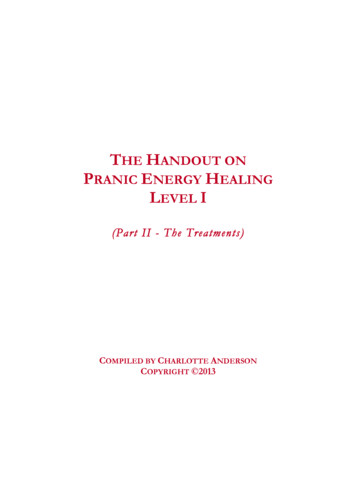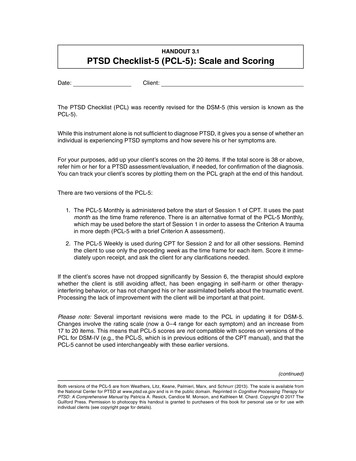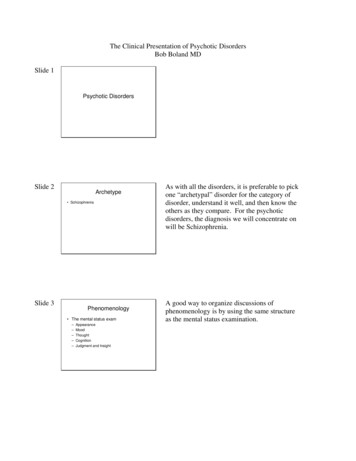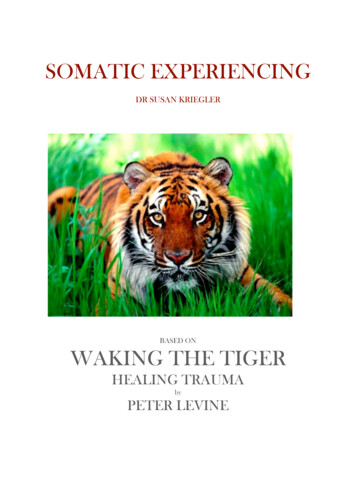
Transcription
SOMATIC EXPERIENCINGDR SUSAN KRIEGLERBASED ONWAKING THE TIGERHEALING TRAUMAbyPETER LEVINE
How Does SE Work?Somatic Experiencing was developed by Dr. Peter Levine following his observation thatanimals in the wild do not get traumatized even though daily they are faced with lifethreatening situations. Dr. Levine observed the mechanisms by which animals are able toshake off the high levels of nervous system arousal and return to their daily lives. He thenbegan to ask the question of why humans are so susceptible to the devastating effects oftrauma.What he realized is that as the neocortex evolved, that part of the brain that makes us the mosthuman, giving us the ability to think and ponder deep philosophical questions, our ability tooverride our instinctual responses also came online.Now, in most cases this is a really good thing. We don't have to automatically lash out and killsomeone just because they took our food. We can creatively think up better strategies to deal withthreats.But, as with most things in nature, being given a new and enhanced capability usually involveslosing some part of an old one in its place. In this case the ability to override the instinctualresponses of the nervous system left us with a vulnerability to being traumatized.In SE sessions, clients are encouraged to tune into physical sensation, which creates thespace for our bodies to reconnect with our innate healing response. This naturalisticprocess resolves symptoms by gently discharging the high levels of nervous systemarousal associated with trauma, and helping our bodies return to a more manageablelevel of functioning.As we begin to reset our nervous system, integration organically occurs. The oncefragmented physical, emotional, cognitive, interpersonal, and spiritual aspects of who weare can once again work together as a whole. This integrative process is deeply healingand enlivening.
The Autonomic Nervous System (ANS)First, let's look at some of the underlying theory on which SE is built. We start with the PolyvagalTheory of Dr. Stephen Porges at the University of Illinois.Physiologists and medical schools are still teaching (incorrectly) that the ANS exists in two states(or phases): fight or flight (sympathetic) and rest and recuperation (parasympathetic).Dr. Porges observed that we actually have three states in the ANS which form a heirarchy. Hecalls these states 'Social Engagement' which is parasympathetic, 'Fight or Flight' which issympathetic, and 'Freeze' which is parasympathetic and sympathetic activation simultaneously.In the human nervous system we still have freeze / dissociation as an algorithm that can be run toprotect us. But, in humans it is a bit more complicated. In most cases we can at least partiallyoverride freeze. Most people have never fully fainted in fear. But, most of us have temporarilybeen unable to move, or have spaced out, or went speechless in fear.Some people who have had a near death experience have reported 'going out of their body' whenin great pain or fear. In this last case they may report hearing a scream coming from over there,and then realize that that is their own body over there doing the screaming. These are all aspects offreeze/dissociation.We have several synonyms for freeze, including dissociation, immobility, spacing out, deer in theheadlights look. In the healthy nervous system it still serves and protects us humans, but oftenfreeze is associated with the residual crippling effects of trauma. Here's what happens that causeshumans to get stuck in trauma.
When we are faced with a life threatening crisis our nervous system develops a motor plan forescaping it. Usually that motor plan begins to be executed, for example running from a predator. But,when that plan is thwarted by being caught in a dead end situation, we go into freeze. Please notethat “life threatening” doesn’t only refer to our physical survival, but also to our emotional survival.Even though we cannot escape, our protective motor plan continues to go around in our brain. Inanimals when they come out of freeze the energy is drained off by running to escape or by therhythmic waves of muscle contractions. This doesn't happen in humans every time, or we overridethe trembling that would help accomplish this.So, we are left highly activated with an incomplete motor plan still going round and round in ourbrain. This motor plan wants to complete and so our unconscious mind may continually place usin situations similar to this one so that we can use the motor plan to complete the movement backto safety.Freud called this a 'repetition compulsion.' But, rarely is the new situation enough like the oldone that the same motor plan can resolve it. Thus, we tend to accumulate more and more traumaswhich are sort of similar to the original. For example someone who is 'accident prone,' or whokeeps having similar sorts of accidents or assaults? This is what's happening in them.The repetition compulsion causes people to stumble from one abusive relationship to the next, orthey provoke the same quarrel they had with their parents, in their marriage. A person may alsoflip from victim to perpetrator, for example if they were sexually abused as a child, they becomean adult sexual abuser of children.These incomplete motor plans continue to run long after the original event. They waste mentalenergy and they continually activate the nervous system towards fight or flight or even push it intofreeze with the right kind of threat. Many people are always hyper, or hypervigilant. They looklike they have had too much coffee. Those are people who have gotten stuck in the sympatheticsystem activation of fight or flight.Many people always look spacey or confused. Those are people who are caught in some degreeof freeze.
Being stuck is like when your computer slows to a crawl when some error causes a program to getstuck in a continuous loop, eating up CPU cycles. You sit there waiting and waiting for the task athand to complete.When the brain is stuck with several of these protective motor plans running all the time becausethey can't complete, our brains run slow and inefficiently, just as our computer does.In Somatic Experiencing what we do is work to resolve the incomplete motor plans and tofacilitate a resilient moving of the ANS from state to state, rather than becoming fixated in onestate.When these old motor plans are allowed to complete in the SE process the nervous system canreturn to processing the task at hand rather than burning up brain power defending against a threatthat is no longer there. This is just like rebooting your computer to get it back up to speed on thetask you want to work on.But the most visible and dramatic sign of being frozen in fight / flight is rapid, shallow chestbreathing (hyperventilation), often accompanied by rapid heart-beat, cold, sweaty hands, andneck spasm.We need to pay special attention to the breath, firstly because it is the respiratory system is thethe only major system in the body which is usually involuntory, but which can also be voluntarilycontrolled.We need to pay special attention to the breath secondly because it is a very powerful and centrallyimportant system. Somewhat like the flywheel in a car engine, the breath regulates all the otherautonomic systems, including brain function.As yogis have known for centuries, controlling and changing the way we breathe, can go a longway towards getting us unstuck from the debilitating effects of central nervous system overactivation.
To restore the balance in the ANS, we need to change the chronic habit of subtle or more obvioushyperventilation (chest breathing) to diaphragmatic (belly) breathing, which is natural innormal, happy people, and all animals. If you don’t believe me, take a look at a happy baby, oryour dog.Evolution of the ANS in MammalsLet's look at how the three Central Nervous System responses work in other mammals and seewhy these states have evolved.Take for instance an impala grazing on the savannah in Africa. The impala will be calm andrelaxed as it grazes with other impalas in its herd. It will be alert and will be orienting to theenvironment around it to assess for potential danger through its senses of sight, smell, and hearing.The other impalas are doing the same, orienting to possible danger and orienting to each other forsigns that they spot danger. If they see a dangerous situation they will alert the herd to it.The impala gets a jolt of adrenaline. Its nerves become activated with electric charge. Its musclestense. Blood begins to shift from its abdominal organs and its periphery to its large muscles toprepare it for flight. The lioness is still far enough away as to not pose immediate danger so theimpala continues to track the lioness with his senses.At a certain point the lioness goes away. The impala now has to deal with all of the energy that hasbuilt up in its system that is no longer needed to flee from the lioness. It does this by a rhythmicshaking in waves of muscular discharge. The flight energy is dissipated and the impala goes backto grazing.In another scenario the lioness crosses an imaginary line that is close enough for it to be a threat tothe impala. The impala takes off running to escape the hungry lioness. He is now actively in fightor flight.His behavior is flight. His nervous system state is fight or flight. The charge that had built up in theimpala is coming in useful at this point, this is life or death.As the lioness closes in on the impala and is just about to grab the impala in its powerful jawssomething odd happens.The impala collapses and can no longer run, can no longer even move. The lioness pounces andgrabs the impala in its jaws. What just happened?
The impala went into freeze. In humans full-on freeze is called fainting. Technically, freeze iscalled the 'dorsal vagal reflex.' How does freeze serve the impala? To the lioness freeze looks likedeath. So, the lioness doesn't have to break the impala's neck because it already appears dead.Because the impala is paralyzed in freeze it can't even lick its wounds, a behavior that wouldsignal the lioness that the impala was still alive.Also, to keep the impala from screaming in pain if it sustained bites, nature assured that in freezethe impala is disconnected from pain by causing dissociation in the brain. With a heavy shot ofendorphins, those heroin like chemicals in the brain, and some rewiring of the brainsswitchboard, the brain literally disconnects the sensory centers from the feeling centers and therest of the brain.The lioness has just run a strenuous race itself and if she laid down right then and there to devourher prey the lioness would be vulnerable to hyenas or other second string predators stealing hermeal.So, the lioness drags the impala back to her lair while catching her breath. Maybe the lioness goesto round up her cubs for dinner. During this time the impala comes out of its freeze state and runsaway. So, what we see here is one more mechanism that evolution has devised to assure survival.Pretty ingenious, no?TraumaThe debilitating symptoms after a perceived life-threatening or overwhelming experience.Its actually about anything that threatens our physical / emotional / social / financial / spiritualsurvival.No two people are alike. We are different in genetic make-up, our history of trauma, and familydynamics. We become traumatized when our ability to respond to a perceived threat is in someway overwhelmed.
Certain kinds of early childhood experiences can severely diminish our ability to cope and bepresent in the world.Especially children can be overwhelmed by what we think of as common everyday events.Over time, a series of seemingly minor mishaps accumulate and can be as damaging as a singlemajor catastrophe.Examples include automobile accidents, routine invasive medical procedures, falling off a bicycle,parents fighting.Trauma can impact in ways that don’t show up for years. Most of us have been overwhelmed by aseries of less dramatic events and have lasting symptoms that are not so obvious.In short, trauma is about loss of connection - to ourselves, our bodies, to our families, to others,and to the world around us. It is often hard to recognize, because it happens slowly over time.We may simply sense that we don’t feel quite right, experience a gradual undermining of our selfesteem, self-confidence, feelings of well-being, and connection to others and life.Our choices become limited as we avoid certain people, situations, and places. The result of thisgradual constriction of freedom is the loss of vitality and potential for the fulfillment of ourdreams.
Human beings are born with an innate capacity to triumph over trauma. Trauma is curable, andthe healing process can be a catalyst for profound awakening - a portal opening to emotional andgeniune spiritual transformation.Obvious Causes of TraumaWar, Natural disasters, Death of loved onesSevere childhood emotional, physical, or sexual abuseNeglect, Betrayal, or AbandonmentParent’s divorceExperiencing or witnessing violenceRape, Armed robberyCatastrophic injuries and illnessImmobilization, Casting, SplintingPre-natal stress / rejectionBirth stress, for both mother and infantIllness of a parent / sibling / grandparentLess Obvious Causes of TraumaMinor car accidents, Falls, Minor injuriesMedical or dental procedures, especially when involving anesthesiaPelvic examinationsBeing left alone, Waiting to be fetched from schoolBeing lost in a strange placeFeeling unloved, criticized, unsupported, unrecognizedParent who drinks, rages, withdraws, gambles, is sick, anxious or depressed,Parent who often comes late, breaks promisesFinacial difficulties in the familyMoving house, Changing schoolsBirth of a siblingHaving a sibling who is more intelligent /gifted / beautiful / popular / lovedIllness, High fever, Food poisoningDeath of petsNot being picked for the team / to be prefectNot being
space for our bodies to reconnect with our innate healing response. This naturalistic process resolves symptoms by gently discharging the high levels of nervous system arousal associated with trauma, and helping our bodies return to a more manageable level of functioning. As we begin to reset our nervous system, integration organically occurs. The once-


